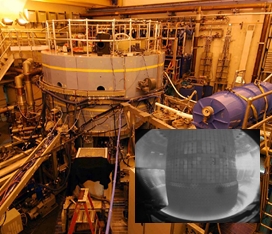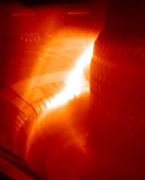 |
 |
| A virtual coffeehouse for
technological minds and ideas |
|
MIT helps inch towards the goal of fusion power One of the most anticipated achievements in technology is electric energy production using nuclear fusion. A virtually limitless fuel supply which "burns" without air pollution is the biggest reason, but there’s also some excitement about the prospect of harnessing the power of the stars through determination and invention. Current estimates range from about five years to never, and this can be frustrating to those who are looking forward to it. The way to get the best possible answer is to ask someone who is working directly on the problem, so we contacted MIT's Plasma Science & Fusion Center and were able to pose some questions to Noah Smick, one of their scientists working with their Alcator C-Mod Tokamak reactor. Q. Your work at MIT has centered on magnetically confined
Noah: Our reactor is purely a research reactor. It is designed to study the plasma physics of fusion and the basic operational issues. It does not achieve sufficiently high temperatures and does not confine the particles for long enough to produce significant fusion reactions. In addition, we don't use the other hydrogen isotope (tritium) that would be required for significant fusion yield. Tritium is very rare, expensive and radioactive and it is not necessary for studying the plasma physics of fusion. (A power plant would have to breed tritium on site, a substantial technological undertaking). The fusion power from D-D ( Deuterium-Deuterium) reactions in our device is about 100 Watts (yes, a light bulb). If we included tritium the D-T fusion reactions would provide about 10kW. A commercial power reactor by comparison would produce at least several GW (billion Watts) of fusion power. We are also unable to produce steady plasmas for a long period of time due to a number of practical limitations. Our plasma pulses last about 2-3 seconds, which is very long for a plasma but not useful for producing power. Q. Do you have any means built into this reactor to capture the released energy from the plasma Noah: No. As stated previously, this is extremely small anyhow. Q. What has your own work with this reactor focused on, and why did you choose that area of focus?
Noah: My work is focused on the use of electric probes to study
conditions in the cool edge of the plasma. This area is
important because the edge plasma provides the boundary
conditions for the core and affects the transfer of particles,
energy and momentum in and out of the confined plasma. Probes
provide a simple way of sampling the plasma but are only useful
in the unconfined edge region where the temperature and density
of the plasma are sufficiently low to allow the probe to
survive. Even so, these probes must be rapidly inserted and
retracted, remaining in the plasma only for a few hundredths of
a second.
Noah: While stars do form natural fusion reactors, they work in a completely different way than anything we can arrange on earth. The plasma in a star is confined by its own gravity instead of magnetic fields. The presence of a central force pulling the plasma inwards makes the star a great deal more stable than a terrestrial arrangement where the plasma is being pushed on from the outside. Unfortunately, gravitational confinement can only work for a star-sized chunk of plasma. That is, it does not scale down and is useless for a man made reactor. The stars also enjoy another significant benefit. They are large and dense enough that they are 'optically thick' to their own radiation. This means that most of the thermal radiation is not lost from the system, but is re-absorbed, keeping the star hot. This allows the fusion burn to proceed (albeit very slowly) at much lower temperatures than we require for an earth-based system. (The center of the sun is roughly 15 million degrees compared to a fusion power reactor which would be greater than 100 million). The tenuous plasmas we can confine at high temperatures cannot hope to achieve optical thickness. In fact, we are limited to a density about a million times less than that of air. Q. When a contained and sustainable fusion reaction becomes feasible, which yields a net gain in energy, what do you imagine will be the most probable conversion method to electricity? Noah: The high energy (14 MeV) neutrons emitted by the D-T fusion will be absorbed in a 'blanket' surrounding the reaction chamber. During their absorption they will breed additional tritium fuel from lithium contained in the blanket. The neutrons will also heat the blanket to high temperatures. The heat will be removed with water, driving a conventional steam turbine to produce electricity. Q. Will nuclear fusion power plants most likely be limited to large, base-load scale facilities that serve large populations, or do you imagine that the technology could scale down to something that could power an individual business or home? Noah: The fusion energy schemes which seem the most likely to succeed do not scale down at all. They will only be useful for very large (>1 GW-electric) installations. The lack of scalability is one of the challenges facing fusion researchers as it appears to be impossible to build a functioning power reactor at anything less than a massive scale. Q. Do you have your own guess for how much longer practical fusion energy may take? Noah: I think the 30-50 year forecast is correct, assuming sustained government support. However one could imagine technological innovations which would greatly accelerate things (breakthroughs in superconducting magnet technology, for instance). Q. Philo Farnsworth (who developed television) designed a machine called a fusor, which demonstrated an actual fusion process in the 1960s. His machine used electrostatic charges to contain the fusion but was very limited and could never deliver a net gain in energy. There has been a lot of talk recently about successful testing, and possibly using electrostatic confinement in the future. Is your group doing any work in this direction and do you feel it has promise? Noah: While a fusor (along with a great deal of other methods) can produce fusion reactions, it appears highly unlikely that electrostatic confinement can be used to create a productive fusion reactor. The most obvious stumbling block is that a purely electrostatic device like a fusor requires its electrodes to be in direct contact with the hot plasma. In a power reactor, no physical material could long withstand such a configuration. More complicated hybrid systems which use combinations of magnetic and electrostatic confinement may be able to avoid this issue, but begin to suffer from the same problems as any magnetic confinement system (e.g., complicated and expensive). No such configuration has yet demonstrated performance approaching that of a tokamak. It is therefore not being pursued at MIT as a fusion energy candidate. Q. What do you think are the most exciting near-term projects going on that people who are interested in fusion energy should be watching? Noah: In my view the most exciting fusion project from the perspective of energy production is the international 'ITER' project currently under construction in Cadarache, France. ITER will be the world's largest Tokamak, the result of a collaboration between the EU, Japan, the US, China, Korea, India and Russia. It should be the first magnetic confinement device to demonstrate a burning plasma (one that is sustained in large part by the heat from its own fusion reactions) and the first fusion device to generate a net power gain. While it will not have the necessary facilities for harvesting the power it produces, it is expected to produce 400MW of fusion power, greatly exceeding anything that has been done previously. It should also be able to operate for extended pulses (many hours) and possibly even in steady state. It will be a great step towards practical fusion and should go a long way towards enabling a full scale demonstration power reactor. |
add to favorites
|
 del.icio.us
del.icio.us
 Slashdot It!
Slashdot It!
 Stumble It!
Stumble It!
Home | About Us | Advertise | Submit an Article | Submit a Link | Contact Us
ElectronCafé.com is a registered property of electricalfun.com Copyright © 2008 - All rights reserved


